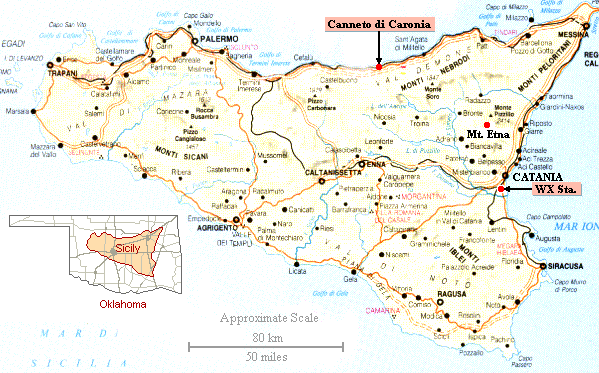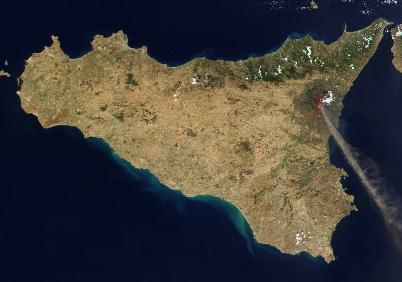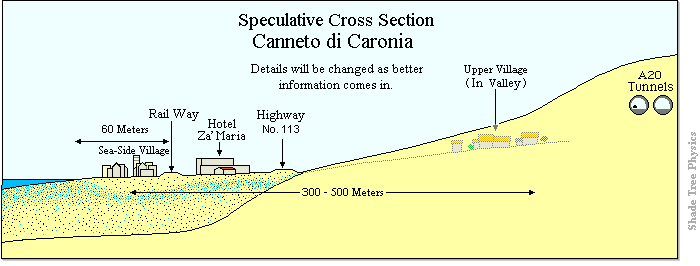Prev | 1 | 2 | 3 | 4 | 5 | Next
Town Battles 'Demonic' Mystery Blazes
Wed February 11, 2004 09:57 AM ET
ROME (Reuters) - A Sicilian town is struggling to work out why dozens of household items from fridge-freezers to furniture keep mysteriously bursting into flames, terrifying locals and sparking theories of demonic intervention.
Since mid-January dozens of electrical goods and pieces of furniture have spontaneously gone up in flames, causing huge damage in Canneto di Caronia, a small town perched on the Mediterranean island's rocky coast.
"I've seen unplugged electrical cables burst into flames with my own eyes, but I just can't explain it," a local
policeman who did not want to be named said Wednesday. "I've never seen anything like it."
. . .
Italian utility Enel tried cutting power to the town after the first reports but the fires continued. With experts no
closer to explaining the phenomenon, theories ranged from arson to a freak power surge or even the supernatural.
. . .

Map of Sicily Showing Location of Canneto di Caronia
"Appropriated" from http://www.sicilian.net/maps/. (No longer available.)
(In-depth story in Italian - Added 13 Feb 2004.)
Il paese assediato dal fuoco misterioso
(The following article and comment were added on 14 March 2004.)
A Canneto di Caronia (ME)
In this last article a researcher dismisses supernatural involvement (the Devil) and fraud, and goes on to suggest some natural phenomena which may ultimately explain the fires. The article is written in Italian, but if you go to Google.com and use the search stream A Canneto di Caronia (ME), it should pop up as the first listing. By using Google's translation option you can get a fair gist of the ideas discussed. The web page also has several good links to more aspects of the Canneto fires problem. (Translation note: "Canneto" means "cane field" in Italian.)
* * *
If there were to be a large concentration of electrical charges (of one polarity) in a region, and at the same time there was low relative humidity, (Sicily is known to normally have low humidity.) one might then expect household dust to become charged and to become airborne due to its electrostatic repulsion by the charged Earth. (The dust and Earth would both be charged with the same polarity in this case.) Airborne dust in the proper concentrations can be explosive. (Grain elevator fires come to mind.)
Volcanic ash is flammable. When was the last time Mt. Etna's plume deposited ash on Canneto di Caronia? [Added 14 Feb 2004. According to a Canneto source, that event occurred in about February of 2003. See the 21 Feb Update.]
Appliances generally make electrical sparks when turning on or off. Furniture, constructed with iron or steel parts which have some freedom of movement (open bottomed box-spring beds, and couches, for example) may produce sparks when the metal parts scrape or rub each other.
Sparks combined with explosive dust concentrations may be the primary sources of the fireworks.

Space Image of Sicily Showing Mt. Etna Plume
17 Feb 2004 - Author's Notes
I speculate that the Etna volcanic ash episode took place in the
fall of 2003(*). It would have occurred when the weather on Sicily was still
warm enough for people who live in un-airconditioned houses to have their
windows open (for cooling) a large part of the time. The ash involved in the
fires probably was that which settled under hard to get to places, like
under refrigerators, beds, sofas, etc. One recent story covering the fires,
in fact, mentions fires associated with these mentioned items. (*)Thanks to
Jeroen Goulooze for catching a "2004" boo boo.
A section about Canneto being perched on a cliff has been removed.
21 Feb 2004 - Update
A friend of the author who lives in Perugia Italy, phoned the staff of the
Hotel Za' Maria in Canneto di Caronia
and reports the following info.
(A follow-up call to the hotel by the author provided some amplifying
information which will be enclosed in parentheses. Thanks to the hotel
staff for providing an English speaking interpreter.)
The elevation of Canneto di Caronia is very near to that of sea level. The village itself is NOT on a cliff. (There is a beach between the village and the sea.)
Nearby there is a 300 meter high cliff with another small village. (The cliff is located some 300-500 meters inland [South] of Canneto.)
Ashes from Mt. Etna were deposited on Canneto di Caronia about a year earlier than February 2004].
The hotel staff contact person informed my friend that "by now all the phenomena seem reducing." [seem to have abated].
Readers who have been in the area, or who have additional information related to the topics under discussion, are invited to contact me to help bring the phenomenon into better focus. Pictures would be very helpful. An aerial photo showing Canneto di Caronia with the nearby cliff would be most helpful. [Got one! 14 Mar 2004.]
According to a 10 February 2004 Guardian newspaper report the houses in which the fires had broken out were all in an area 350 metres (parallel to the coast) by 70 metres between the shoreline and the railway. [Added 13 March 2004. Modified 14 Feb 2016.]
Nicholas Hawkins, who visited the area on about 8 March, says that the "cliffs" south of (inland from) Canneto di Caronia, are in fact, steeply rising rock, and not vertical. (What is the name of the village on top of the "cliffs?") [Added 13 March 2004.]

[Diagram added 13 Mar 2004. Latest update 21 Aug 2013. Moved to Part 1.]
Click on the Google Earth Space Photo of Canneto di Caronia to see the actual Canneto area. [Added 27 July 2006.]
24 Feb 2004
We do not have to limit our considerations to Mt. Etna as a possible source
of recently deposited volcanic ash at Canneto di Caronia. The photo below
shows ash erupting from Mt. Stromboli which is the northeasternmost of the
Aeolian islands, located some 55 nautical miles northeast of Canneto di
Caronia.

© J. Alean
See the NOAA Air Resources Laboratory Volcanic Ash Forecast Transport and Dispersion (VAFTAD) web page. Web site provides ash dispersal modelling volcanoes around the world based on current meteorological conditions. [Added 25 Feb 2004. Link changed 30 Mar 2010.]
25 Feb 2004 - Volcanic Ash Electrical Discharges
According to a webpage by the Institute of Geological and Nuclear Sciences,
Ltd., titled
Volcanic hazards in New Zealand, [Volcanic] "Ash clouds can generate powerful electrical fields
producing intense and frequent lightning discharges, which can interfere with radio communications
and damage electrical installations, or start fires in buildings and installations."
The above statement apparently pertains to large-scale atmospheric electrical activity but the events at Canneto di Caronia may represent small scale versions of the process. (Whether or not volcanic ash was a factor in the Canneto fires is yet to be determined.) The author solicits inputs from individuals who have done experiments on small-scale electrical discharges (micro-lightning?) by volcanic ash, or who can provide anecdotal evidence that the phenomenon occurs.